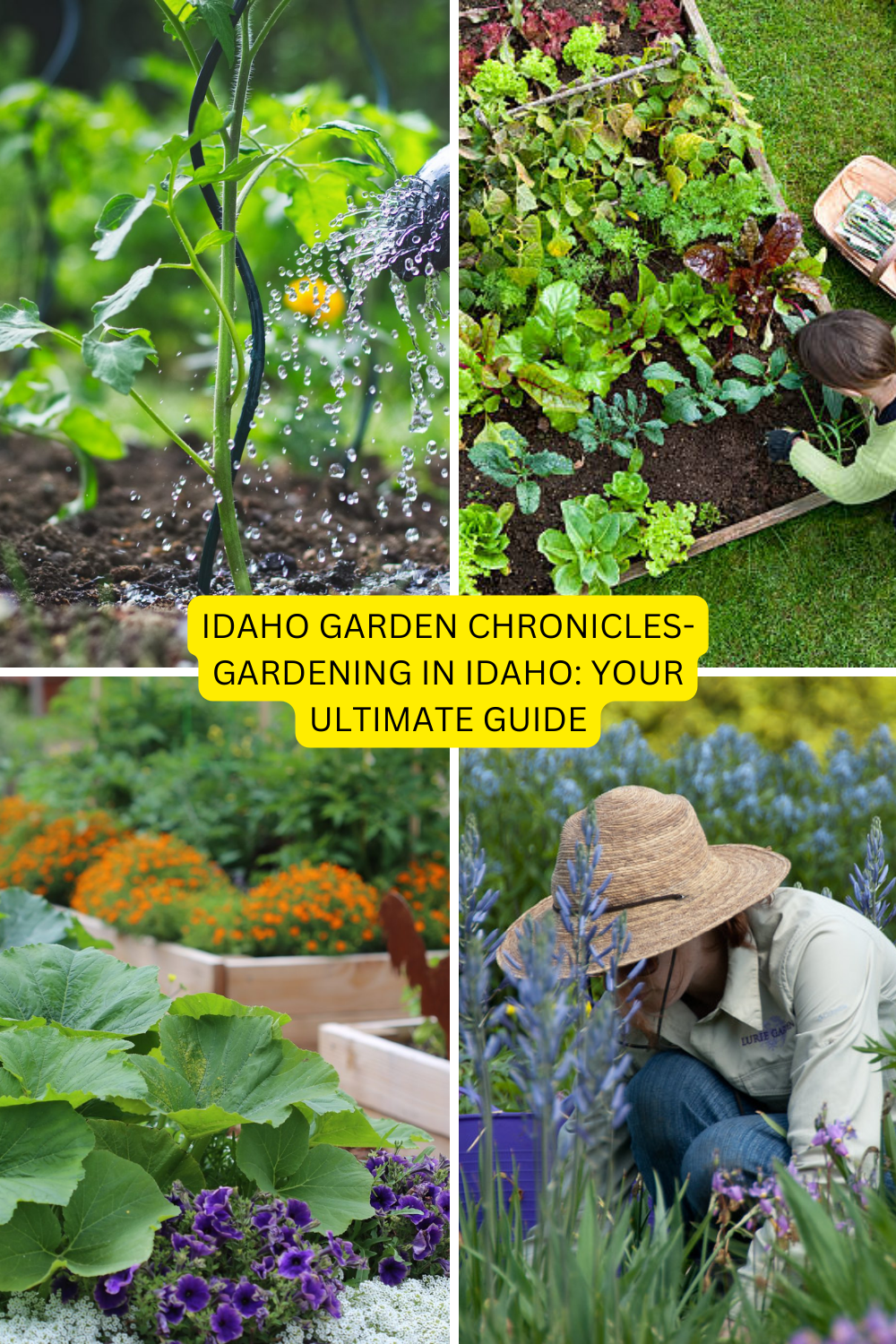Welcome to gardening in Alabama blog. Are you ready to embark on a journey through the lush and vibrant gardens of Alabama? Whether you’re a seasoned gardener or just starting out, our blog is here to guide you through the unique joys and challenges of gardening in the Heart of Dixie.
1. Climate of Alabama
- USDA Hardiness Zones: Alabama falls within USDA hardiness zones 7b to 9a, meaning gardeners can grow a wide variety of plants.
- Temperature: Summers are hot and humid, with average temperatures ranging from 80°F to 90°F. Winters are mild, with temperatures rarely dipping below freezing.
- Rainfall: Alabama receives ample rainfall, averaging 55 inches per year, which is beneficial for many crops but requires good drainage to prevent waterlogging.
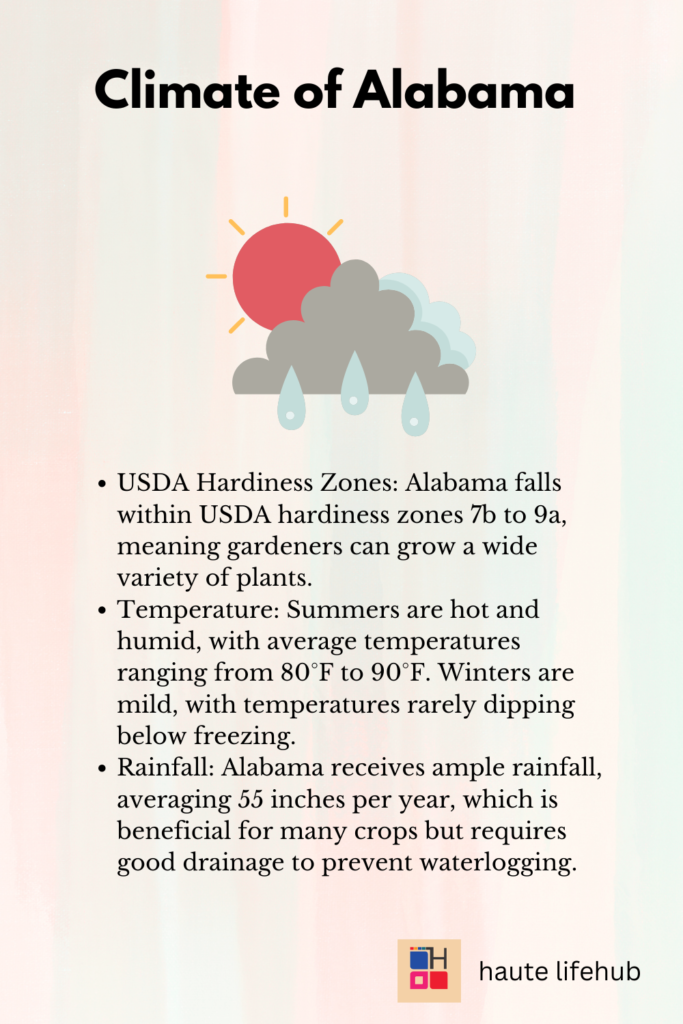
2. Soil Types in Alabama
Gardening in Alabama offers a delightful variety of soil types, each with its unique characteristics and requirements. To help you get started, here’s an overview of the soil types you’ll encounter and tips on how to prepare your garden for success.
Sandy Soils:
- Location: Predominantly found in the coastal plains.
- Characteristics: Well-draining, warms up quickly in spring but may require more frequent watering.
- Tips: Sandy soils can benefit from the addition of organic matter to improve water retention and nutrient content.
Clay-Heavy Soils:
- Location: Common in the central and northern regions.
- Characteristics: Dense, slow-draining, and can be challenging to work with, especially when wet.
- Tips: To improve clay soils, incorporate organic matter such as compost or well-rotted manure. This helps enhance drainage and soil structure.

Soil Testing of Alabama
By understanding and managing the soil in your garden, you can create an environment where your plants will thrive. Stay tuned for more tips and tricks to help you make the most of Alabama’s diverse and fertile soils! Testing your soil is a crucial step in ensuring a healthy and productive garden. Here’s why and how you should do it:
- Why Test? Soil testing provides essential information about your soil’s pH and nutrient levels. Alabama’s soils can often be acidic, which may affect plant growth.
- How to Test: You can get a soil test kit from your local extension office or garden center. Follow the instructions to collect soil samples from different parts of your garden and send them to a lab for analysis.
Adjusting Soil pH of Alabama
- Understanding pH: The pH level of your soil affects nutrient availability to plants. Most garden plants prefer a slightly acidic to neutral pH (6.0-7.0).
- Using Lime: If your soil test shows that your soil is too acidic, you can add lime to raise the pH. The amount of lime needed depends on the current pH and the type of soil.
3. Selecting the Right Plants in Alabama
Vegetables of Alabama
- Spring: Tomatoes, peppers, squash, beans, cucumbers, and eggplant.
- Summer: Okra, sweet potatoes, melons, and Southern peas.
- Fall: Broccoli, kale, carrots, lettuce, spinach, and radishes.
- Winter: Garlic and onions.
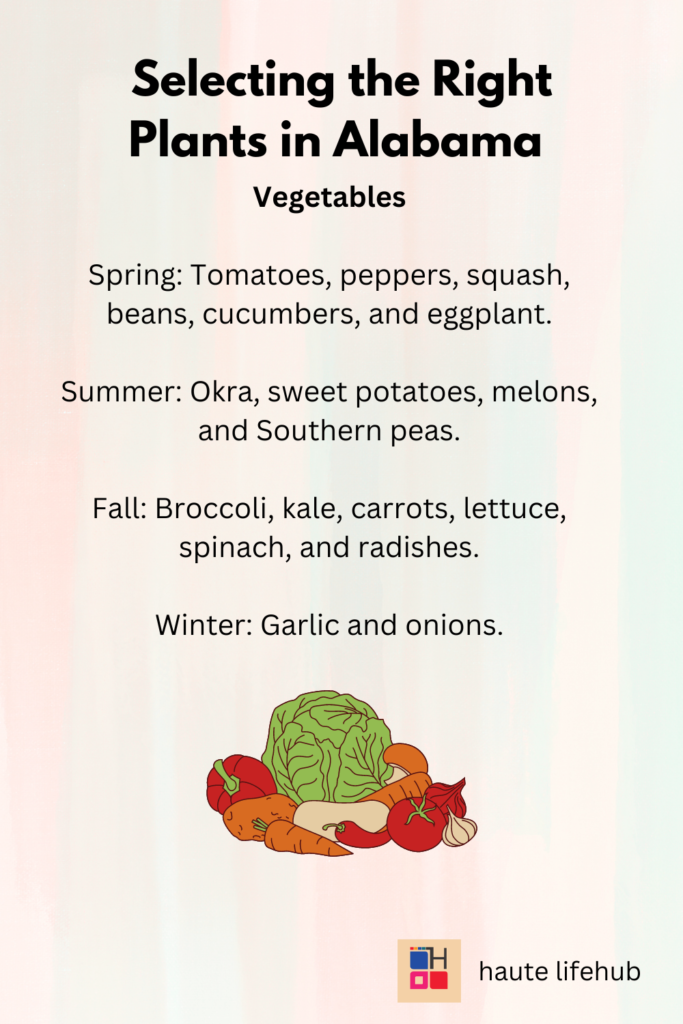
Fruits of Alabama
- Berry Bushes: Blueberries and blackberries thrive in Alabama’s climate.
- Fruit Trees: Apples, peaches, figs, and pears are well-suited for Alabama gardens. Citrus trees like satsumas can also do well in the southern regions.

Flowers of Alabama
- Annuals: Marigolds, zinnias, and petunias are great for vibrant, seasonal color.
- Perennials: Daylilies, coneflowers, and hostas provide long-lasting beauty year after year.

Herbs of Alabama
- Warm-Season Herbs: Basil, rosemary, thyme, and oregano.
- Cool-Season Herbs: Cilantro, parsley, and chives.

Native Plants of Alabama
- Why Choose Natives: Native plants are well-adapted to local conditions and require less maintenance.
- Examples: Eastern red columbine, black-eyed Susan, purple coneflower, and Southern magnolia.
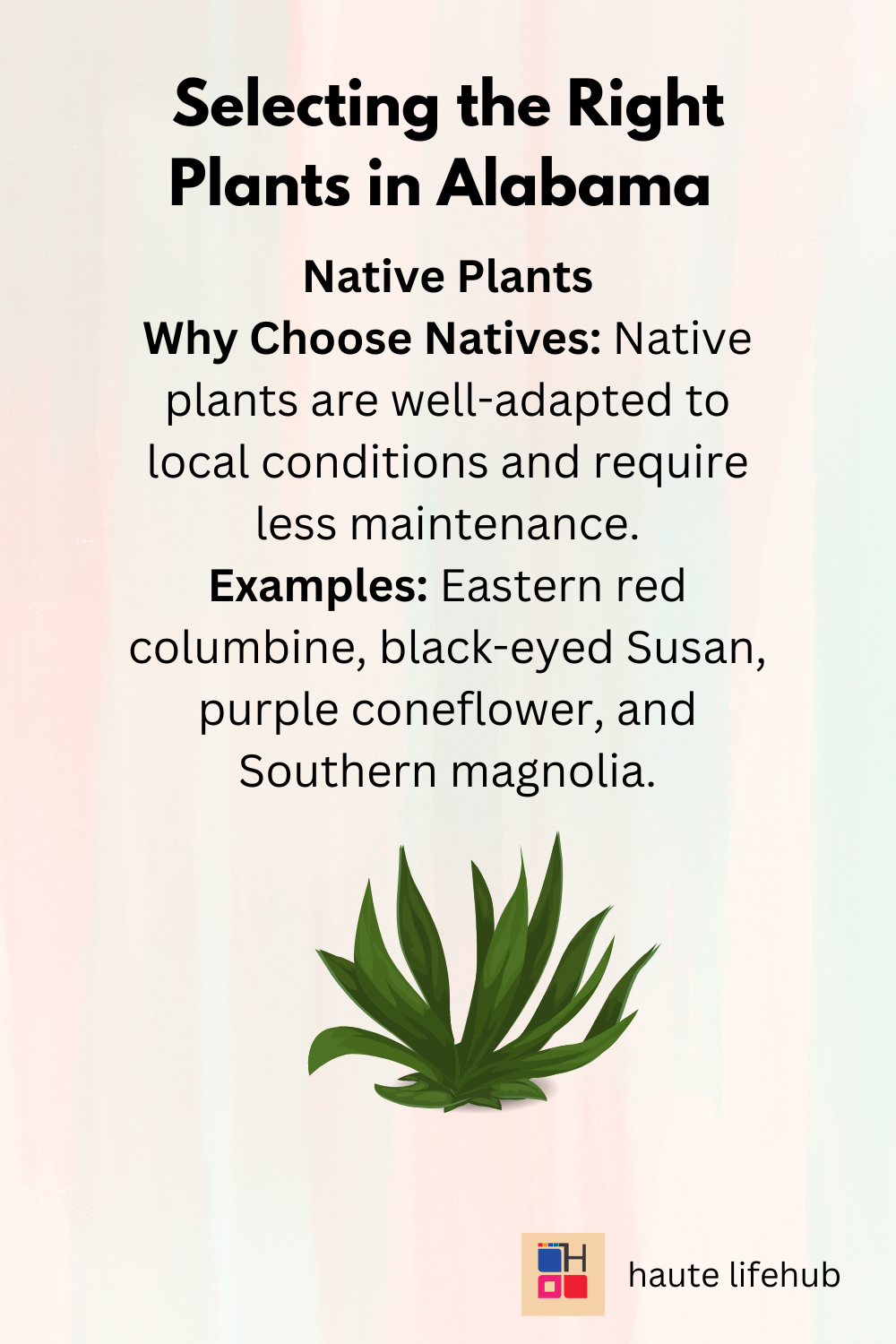
4. Watering Practices of Alabama
- Drip Irrigation: This is one of the most efficient watering methods. It delivers water directly to the plant roots, minimizing evaporation and reducing the risk of disease by keeping foliage dry.
- Soaker Hoses: These hoses provide a slow, steady supply of water directly to the soil, which helps to ensure deep root growth and reduces water waste.
- Hand Watering: For smaller gardens or specific plants, hand watering allows for precise control. Use a watering wand with a gentle spray to avoid disturbing the soil or damaging plants.
5. Pests and Diseases in Alabama
Gardening in Alabama means dealing with a variety of pests and diseases that thrive in the state’s warm and humid climate. Here are some common issues and tips for managing them:
Common Pests of Alabama
- Aphids
- Description: Small, soft-bodied insects that suck sap from plants.
- Signs: Curled leaves, sticky honeydew residue, and sooty mold.
- Control: Use insecticidal soap, neem oil, or release beneficial insects like ladybugs.
- Tomato Hornworms
- Description: Large green caterpillars that feed on tomato plants.
- Signs: Defoliation, large bite marks on leaves, and frass (caterpillar droppings).
- Control: Handpick and destroy, use Bacillus thuringiensis (Bt), or introduce parasitic wasps.
- Japanese Beetles
- Description: Metallic green beetles that feed on a wide range of plants.
- Signs: Skeletonized leaves, defoliation, and damaged flowers.
- Control: Handpick beetles, use pheromone traps (placed away from plants), or apply milky spore disease to target larvae.
- Squash Vine Borers
- Description: Larvae of a clearwing moth that bore into squash vines.
- Signs: Wilting plants, sawdust-like frass near the base of the plant.
- Control: Use row covers, inspect and remove larvae, and apply beneficial nematodes to soil.
- Spider Mites
- Description: Tiny, spider-like pests that feed on plant sap.
- Signs: Yellowing leaves, fine webbing, and stippling on leaves.
- Control: Increase humidity, spray with water, use insecticidal soap or neem oil.

Common Diseases of Alabama
- Powdery Mildew
- Description: Fungal disease that appears as white powdery spots on leaves and stems.
- Conditions: High humidity and poor air circulation.
- Control: Improve air circulation, water early in the day, apply fungicides (sulfur or potassium bicarbonate).
- Blossom End Rot
- Description: Physiological disorder causing dark, sunken spots on the blossom end of fruits (e.g., tomatoes, peppers).
- Causes: Calcium deficiency, inconsistent watering.
- Control: Maintain consistent soil moisture, mulch, and add calcium supplements if needed.
- Late Blight
- Description: Fungal disease affecting tomatoes and potatoes, causing dark, water-soaked lesions on leaves and fruit.
- Conditions: Cool, wet weather.
- Control: Remove and destroy infected plants, apply fungicides (chlorothalonil or copper-based).
- Southern Blight
- Description: Fungal disease causing wilting and stem rot at the soil line.
- Conditions: Warm, humid conditions and poorly drained soils.
- Control: Rotate crops, remove and destroy infected plants, and apply fungicides.
- Root-Knot Nematodes
- Description: Microscopic worms that cause galls on roots, leading to stunted growth and yellowing leaves.
- Conditions: Sandy soils and warm temperatures.
- Control: Rotate crops, plant resistant varieties, use solarization, and apply beneficial nematodes.
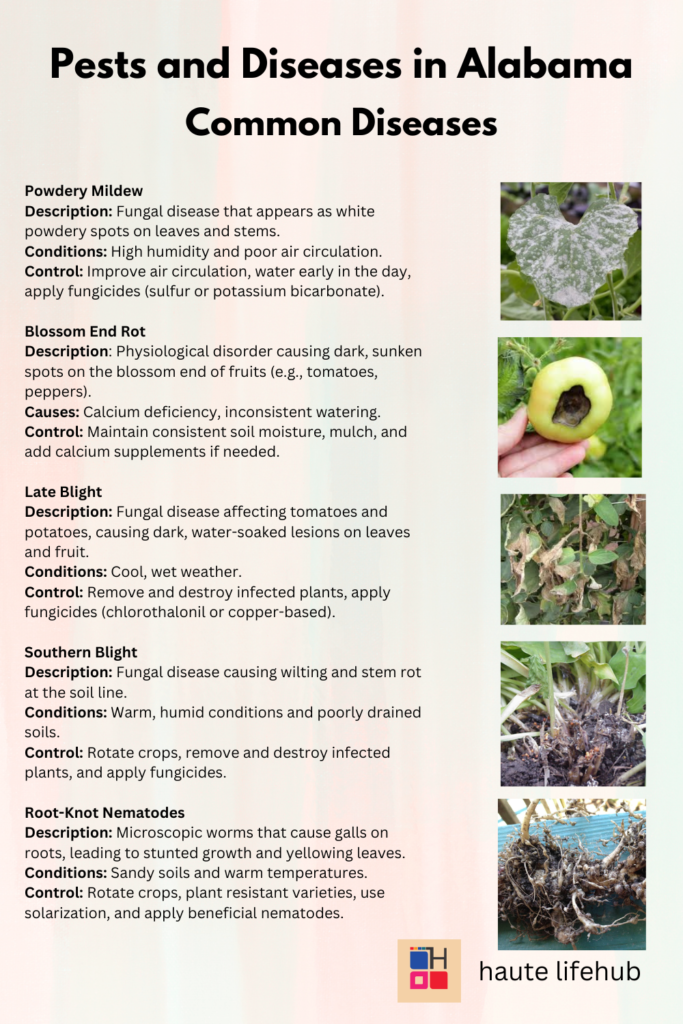
Integrated Pest Management (IPM)
- Cultural Practices
- Rotate crops annually to disrupt pest and disease cycles.
- Practice proper spacing to ensure good air circulation.
- Use mulch to prevent soil-borne diseases and retain moisture.
- Biological Controls
- Introduce beneficial insects like ladybugs, lacewings, and parasitic wasps.
- Use microbial insecticides like Bacillus thuringiensis (Bt).
- Chemical Controls
- Use insecticides and fungicides as a last resort, choosing the least toxic options.
- Follow label instructions carefully to avoid harming beneficial organisms.
- Mechanical Controls
- Handpick pests and remove diseased plant material.
- Use physical barriers like row covers and netting.
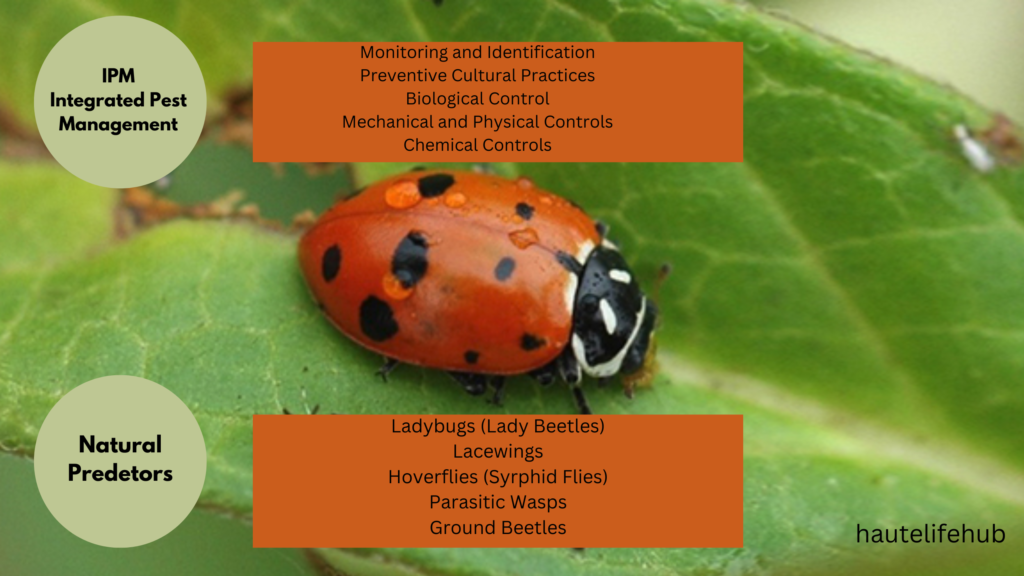
6. Community Resources for Alabama Gardeners
Alabama offers a variety of community resources for gardeners, ranging from local cooperative extensions to gardening clubs and online forums. Here are some key resources to help Alabama gardeners succeed:
Cooperative Extension Services
Alabama Cooperative Extension System (ACES)
- Services: Provides research-based information on gardening, pest management, soil testing, and more.
- Resources: Publications, workshops, and online resources.
- Contact: Visit the ACES website or call your local extension office.
Soil Testing Labs
- Services: Soil testing for pH, nutrient levels, and recommendations for soil amendments.
- Contact: Submit samples through the Alabama Cooperative Extension System.
Gardening Clubs and Organizations
Alabama Garden Clubs, Inc.
- Services: Offers networking opportunities, gardening education, and community projects.
- Contact: Visit the Alabama Garden Clubs, Inc. website for membership information and events.
Master Gardener Programs
- Services: Volunteer program offering advanced horticultural training and community outreach.
- Contact: Join through the Alabama Cooperative Extension System.
Local Gardening Clubs
- Services: Many towns and cities have local gardening clubs that offer meetings, workshops, and plant swaps.
- Contact: Check with local community centers or libraries for information on nearby clubs.
Community Gardens
Birmingham Botanical Gardens
- Services: Offers community garden plots, educational programs, and volunteer opportunities.
- Contact: Visit the Birmingham Botanical Gardens website for more information.
Jones Valley Teaching Farm
- Services: Provides urban farming education, community garden plots, and youth programs in Birmingham.
- Contact: Visit the Jones Valley Teaching Farm website for details.
Local Community Gardens
- Services: Many cities have community gardens where residents can rent plots and participate in gardening activities.
- Contact: Inquire at local parks and recreation departments or community centers.
Online Resources and Forums
ACES Website
- Resources: Extensive library of articles, guides, and videos on gardening topics specific to Alabama.
- Contact: ACES website
GardenWeb Forums
- Services: Online forums for sharing advice, asking questions, and connecting with other gardeners.
- Contact: Visit the GardenWeb Forums and search for Alabama-specific threads.
Alabama Gardener Facebook Groups
- Services: Social media groups where local gardeners share tips, photos, and experiences.
- Contact: Search for “Alabama Gardeners” on Facebook to find active groups.
Educational Programs and Workshops
Local Extension Offices
- Services: Offer workshops on a variety of gardening topics, from basic gardening skills to advanced techniques.
- Contact: Visit the ACES website to find your local office and upcoming events.
Botanical Gardens and Arboretums
- Services: Many botanical gardens offer classes, tours, and hands-on workshops.
- Contact: Check websites for places like the Birmingham Botanical Gardens and Huntsville Botanical Garden.
